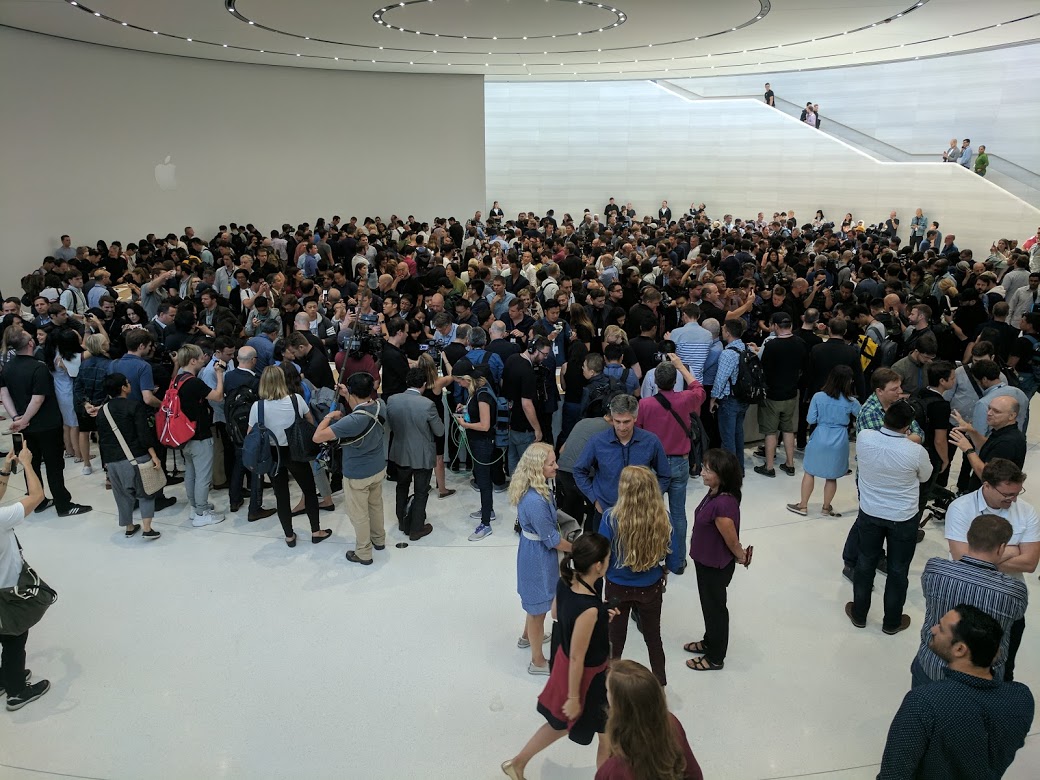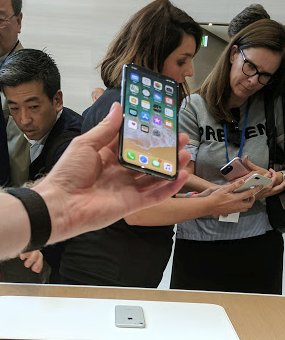

After the presentation at Apple on Tuesday, the press was invited to a hands-on area just outside the Steve Jobs Theater on Apple’s new “Apple Park” campus. We got to see the new products up close, and got a little bit of hands-on time with them. Obviously, tinkering with a device under the watchful eye of an Apple employee isn’t the same as a full fledge review, but it is enough to get some first impressions.
First impressions

It’s hard to argue with Apple’s contention that the iPhone X is the “future of the smartphone,” but at a starting price of $999 for 64 GB of storage or $1,149 for 256 GB, it’s beyond the reach of most consumers. Having said that, I expect lines at Apple stores because there are more people willing to pay that for a new iPhone than there will be iPhone Xs during the first few weeks or months as Apple ramps up production.
What most impressed me is how you can unlock it with your face. I didn’t go through the enrollment process for my own face, but I watched up close as Apple employee unlocked it in seconds. Apple isn’t the first company to introduce facial recognition, but it seem to have gotten it right.
I did get a chance to feel how nice the phone feels in the hand and gaze at the beautiful display. I also experienced how easy it is to get to the home screen by swiping up from the bottom, now that the iPhone X doesn’t have a home button.
In terms of specs, the phone has a 5.8 inch OLED display and, unlike previous iPhones, there is virtually no wasted real estate in the form of bezels on top and bottom. Gone is the home button so the front of the phone is essentially one big glass screen.
What Apple calls the “Super Retina Display,” has a resolution of 1,125 by 2,436 pixels and its Apple’s first phone with an OLED (Organic Light Emitting Diode) screen. In general, OLED gives you crisper images, blacker blacks and richer colors.
New iPhone 8 models
Apple also introduced the 4.7-inch iPhone 8 (starting at $699) and the 5.5-inch iPhone 8 Plus ($799). The two “8” phones have a new all-glass design but otherwise look pretty much like the iPhone 7, complete with the home button and large bezels on top and bottom.
Cameras
The phones have a 12 megapixel wide angle camera with “portrait mode” that enables you to have a crisp foreground and a blurred background. There is also optical image stabilization and what Apple calls “Quad-LED True Tone flash. The home button has Touch-ID, just like the iPhone 7. The new cameras have larger and faster sensors, according to Apple. The cameras also have what apple calls “portrait lighting” that allows you to adjust the apparent lighting on your subject either as you take the picture or later. This mimics the technique used by professional portrait photographers who accomplish this with actual light. The 8 Plus has a wide-angle and telephoto camera, enabling both telephoto and portrait mode, while the 9 has only a wide angle camera. Apple says that its image sensor signal processor detects elements in the scene and “optimizes your photos even before you take them.”
There is also a 7MP front facing camera that includes image stabilization.
Like the X, the iPhone 8 screens have a True Tone display, which adjusts the white balance to match the area’s lighting, making colors more realistic.
Wireless charging on all new models
All new iPhones have wireless charging, enabling you to set the phone down on a pad to charge rather than connecting a cable. This feature has long been available on phones from Samsung and other companies and Apple will be using the Si charging standard, widely used by other companies.
Bionic chip
As always, Apple has update the iPhone’s processor, this time with the “A11 Bionic” chip. This 6-core processor is said to improve the performance of Siri, the phone’s camera and is essential for Apple’s new facial recognition feature in the iPhone X. It will also play a role in augmented reality apps and artificial intelligence features. The phones will also have a Graphics Processor (GPU) that will speed up all graphic intensive tasks, including augmented reality.
Are they worth it?
It’s always a good question as to whether an expensive device is worth the price. To put these phones in context, there are plenty of good Android phones as low as $200 that pretty much do the same thing as even the iPhone X. All iPhones have a fit and finish that just feels good in the hand, an operating system that’s easy to use and reliable, excellent cameras and other nice features, but that’s also true of a lot of Android phones.
To ask whether $999 is too much to pay for a phone is like asking if $10,000 is too much to pay for a Rolex Watch or $75,000 is too much to pay for a luxury car. Those who crave these toys and have the money to buy them obviously don’t think so. But even for those who aren’t extremely well-heeled, it’s fair to say that we spend a lot of time with our phones — often more time than we spend on our cars, our appliances and other possessions. And they do so much so in the scheme of things, I can see lots of people justifying paying more for something that brings them so much pleasure and productivity.